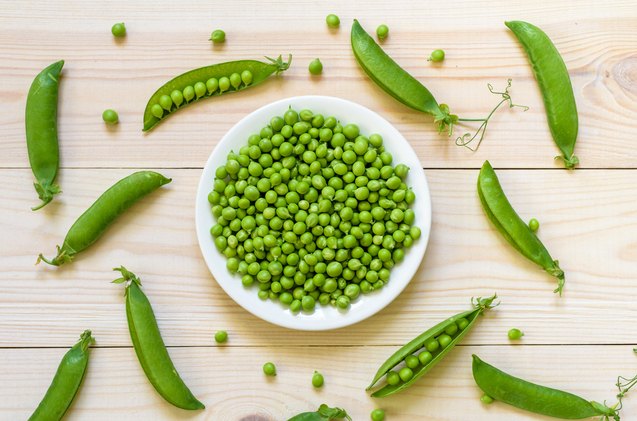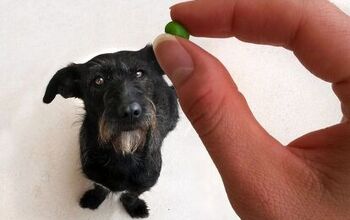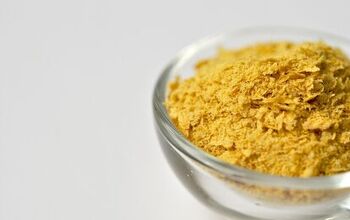Can Dogs Eat Peas?

Today, high-quality dry and wet food for dogs are enough for a well-balanced canine diet. Store bought food is specially formulated to meet their nutritional needs, and, unless there’s an underlying medical issue that requires it, chances are you won’t have to supplement their diet with any additional vitamin and micronutrients sources.
However, this doesn’t mean that, just because your pooch’s kibble has synthetic vitamins and minerals, you shouldn’t give your pooch some nutritious fruits and veggies as a treat. For most dogs, having a few bites of a sweet, juicy fruit or a crunchy veggie will be a special treat! Additionally, adding fruits or vegetables that dogs can safely eat to their diet can have its benefits, from improving digestion to supporting their overall health.
But, while the idea of sharing food with your four-legged companion might sound tempting (it’s hard to resist those sad puppy eyes, right?), you shouldn’t do it unless you’re sure that the human food you’re offering to your dog won’t harm them. For instance, a handful of raisins or macadamia nuts could be landing your pet into the emergency vet room in a life-threatening condition. So, where do peas land on the list? Can dogs eat peas?
As they’ve evolved alongside humans, dogs can digest (and benefit from) a lot of foods we eat on a daily basis. Primarily, this includes various species of fruits and vegetables, but not all of them- some can be highly toxic to dogs. Peas, however, are perfectly safe for dogs.
The human race has been cultivating this edible plant for millennia, and it’s not a surprise to learn that peas are amongst one of the healthiest veggies that you can feed to your four-legged companion. Technically, though, peas are not a vegetable- from a botanical standpoint, they’re considered to be a fruit.
As they’re free of any substances that could be potentially harmful to dogs, there’s no doubt about can dogs eat peas safely. Does that mean that all types of peas are made equal when it comes to canine consumption?
Dogs can eat the following types of peas:
- Green peas
- Garden peas (shelled)
- English peas
- Snow peas
- Sugar snap peas
- Split peas
- Frozen peas
Or, to be concise, dogs can eat most types of peas and in most shapes and forms. There are, however, a few caveats to giving your pet peas.
While peas belong to the category of veggies that are safe for dogs (or fruits, if you want to get nitpicky), there are a few downsides and risks you should be aware of.
First of all, it should be noted that canned peas are not recommended for dogs. As it is usually the case with canned foods, they contain a lot of sodium, as well as additives and preservatives that could be potentially unsafe for canines. The same goes for pea pods– while they’re not toxic to dogs per se, their tough texture could be hard for our furry friends to digest. Furthermore, pea pods can be a potential choking hazard, particularly for small dogs, and can get lodged in your pet’s digestive tract. All in all, it’s best to shell garden peas before sharing them with your pooch!
There is one case in which canines should steer clear of any type of peas. For dogs who have renal disease, the answer to ‘can dogs eat peas’ is, unfortunately, no. Peas contain purines, a compound that’s naturally found in various foodstuffs, but it has been linked with the production of uric acid and kidney stones, which can be a potential problem for dogs struggling with renal issues. If your dog has any health problems that involve their kidneys, it’s best to skip on this veggie, and opt for some other delicious and healthy treat that is harmless for them, such as apples or watermelon.
We know that veggies and fruits are good for us, but what about our four-legged family members? Provided that you follow nutritional recommendations and don’t go overboard with plant-based treats, supplementing a well-balanced diet with dog-safe fruits and vegetables can be good for your pooch’s health. Peas are on the list of healthiest pet-friendly veggies, so it’s no wonder that feeding them to your dog has its merits.
Peas are packed with nutrients- from essential vitamins such as A, K, and B groups, to minerals including potassium, zinc, iron, and magnesium, your dog could get a great health boost from a pea snack. To boot, peas are often used in the production of commercial dog foods due to their high protein and fiber content, so don’t hesitate to give a handful of peas to your pet as a snack. Just make sure to adhere to serving rules!
As long as they’re not canned or in their tough pods, you can serve peas whichever way you like! Fresh, thawed, frozen, mashed- the possibilities are endless, really. Here are some of our ideas on how to serve peas to pooches, added to some yummy meals and delectable treats:
If you’re feeding your doggo a dry food diet, this nutritious meal could be added as a side to their kibble. And if you’re cooking for them, this is one of the recipes you’ll want to jot down somewhere. This yummy meal features both split peas and frozen peas in a paw-licking combo with some ground turkey, olive oil, rice, lentils, and carrots. All the goodies in one place!
Who said superfood is for humans only? The protein-packed super seed might be the star of this recipe, but the sneaky peas add great flavor and they’re chock full of vitamins, too. This recipe calls for organic quinoa, ground turkey, garlic (optional), frozen carrots and peas, spinach, parsley, and olive oil. To top things off, you can sprinkle crushed Calcium Carbonate tablets in there, too, or another dog supplement of your choice.
This one is pretty genius- instead of instructing you to go through the ordeal of thoroughly cooking sweet potatoes before baking the treats, you get all the goodies but none the hassle- by swapping them for sweet potato baby food. In addition, you’ll need peas, parsley, vegetable broth, quinoa flour and rice flour to whip these treats up. Easy peasy to make and super yummy- this recipe will come in particularly handy if you have a pupper that’s sensitive to gluten in their food.
If you want to outdo yourself in the department of canine cuisine, you need to try this one out. Not only that this pupper-friendly casserole is made from quality ingredients that are full of nutrients, it’s will be a literal feast to any furry gourmet. Of course, the servings should be adjusted in accordance to your pet’s size- a good rule of thumb is 2-3% of their body mass equals to the weight of one meal. As for the ingredients, you’ll need boiled chicken breasts, brown rice, frozen pea and carrot medley, steamed, chopped celery stalk, pumpkin puree, boiled potato, and unsalted chicken broth to make this casserole for canines.
How many times have you heard the phrase ‘eat your veggies’ while you were growing up? Well, this savory dog treat saves you from having to become your mother and start pestering your pupper to finish up their greens, as it camouflages them into a delicious crunchy cookie. For these sneaky bites, you’ll need to mix whole wheat flour, cornmeal, bran, egg, vegetable oil, chopped green beans, frozen pea and carrot medley, spinach, turmeric, and a bit of parsley. The recipe is pretty flexible so feel free to swap ingredients for any veggie that causes your pooch to upturn their nose.
Unfortunately, this is not a magic recipe that will get your pupper to mind their p’s and q’s with a single bite. The letters stand for peas and quinoa, a winning combination that makes these treats yummy and healthy both! To whip up a batch of these delicious dog treats, you’ll need to mix quinoa flour, peas, flaxseed meal, turmeric powder, applesauce, and an egg in one bowl and bake for about 25 minutes. These cookies are great for canines with sensitive tummies, as the lack of gluten makes the treats lighter and less likely to cause digestive upset.

A proud mama to seven dogs and ten cats, Angela spends her days writing for her fellow pet parents and pampering her furballs, all of whom are rescues. When she's not gushing over her adorable cats or playing with her dogs, she can be found curled up with a good fantasy book.
More by Angela Vuckovic




























